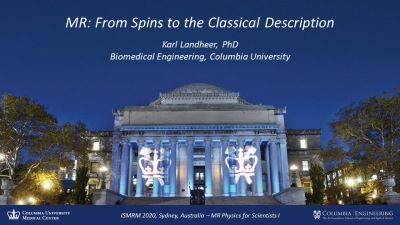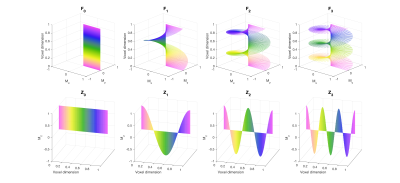Weekend Educational Session
MR Physics for Scientists I
| Saturday Parallel 4 Live Q&A | Saturday, 8 August 2020, 14:00 - 14:30 UTC | Moderators: Contrast Mechanisms: Paula Croal & Ferdinand Schweser |
Session Number: WE-01A
Overview
This course will describe the physics of the magnetic resonance, as well as the machineries (hardware or pulse sequence based) available to the MR physicist to manipulate the evolution of magnetization.
In the second part, there will be an emphasis on the mechanisms that drive relaxation properties in in vivo MRI and the image contrast observed in structural imaging (be it T1, T2 ,or T2* weighted imaging).
The third section of the course will be dedicated to understanding the basic physics of a set of common MRI applications, namely: fMRI, flow, diffusion, and perfusion imaging.
Last, but not least, the interaction of static field, radiofrequency waves, and currents with the human body will be addressed both from a contrast opportunity and safety perspective.
Target Audience
MR physicists and engineers, pulse sequence developers and clinicians who want to deepen their understanding of the MRI acquisition process and how MRI contrast can be optimized for different goals.
Individuals who will likely benefit most from the course are those who have recently completed or are currently following a graduate educational program in MR physics, chemistry, applied mathematics or engineering, and those practitioners of MR with extensive practical experience that seek to obtain a more systematic foundation of MRI.
Educational Objectives
As a result of attending this course, participants should be able to:
- Express a systematic understanding of pulse sequence building blocks and MR system components;
- Demonstrate an in-depth understanding of advanced methods to explore image contrast;
- Describe the physical process behind a wide range of contrast mechanisms (chemical exchange saturation transfer, quantitative susceptibility mapping, BOLD, flow and diffusion amongst others); and
- Critically describe the forms of interactions between the fields used in MRI with subjects tissues or implants and the safety constraints arising from such interactions.
| MRI Fundamentals | ||
 |
MR: From Spins to the Classical Description
Karl Landheer
In this talk the quantum mechanics of a single spin 1/2 particle are discussed. The density operator formalism, which is a method to treat an ensemble of spins is then introduced. The effects of free precession and RF pulses are then demonstrated, and it is shown how the density operator relates to the classical Bloch vector model. A brief overview of how to deal with spin > 1/2 particles or coupled spins which are necessary to describe spectroscopy experiments is discussed. |
|
| MRI: What You Need to Make It Happen – A Hardware Overview
Natalia Gudino
|
||
 |
Bloch Equations: From Steady-State Solutions to Numerical Simulations
Shaihan Malik
This talk is aimed at physicists and engineers who want to understand the different approaches used to simulate MR signals. It will cover steady-state closed form expressions, isochromat simulations, and the extended phase graph method. |
|
| MRS: Beyond Water & Protons, Coupling & Localization
Lijing Xin
MR spectroscopy measures diverse nuclei and molecules beyond water, allowing the measurement of important static/dynamic biochemical information from human or animal organs. This lecture will cover basic knowledge of MRS with a focus on chemical shifts, couplings, spectral modulation, localization methods and polarization transfer.
|
||
| Contrast Mechanisms | ||
| Magnetization Transfer & T1 Contrast: Mechanisms, Sensing & Quantifying
Nikolaus Weiskopf
Magnetic resonance imaging (MRI) yields exquisite soft tissue contrast. This lecture focuses on longitudinal relaxation and magnetization transfer (MT) as contrast mechanisms. For both contrast mechanisms the basic theoretical description and definitions are introduced. It is discussed how they are affected by microstructural characteristics, particularly macromolecular content and myelination in the brain. Different acquisition and analysis methods are described for sensing and quantifying the longitudinal relaxation time (T1) and parameters of MT. Examples of the use of T1 and MT mapping in neuroimaging with a focus on myelin mapping are explored.
|
||
| Chemical Exchange Saturation Transfer: Mechanisms, Sensing & Quantifying
Zhongliang Zu
The purpose of the presentation is to 1) provide an overview of the chemical exchange saturation transfer MRI mechanism, signal enhancement principle, sequences, and quantification methods; 2) analyze the dependence of MTRasym, a commonly used CEST quantification metric, on T1 and magnetization transfer (MT) whose specificity is under debate; 3) introduce a method using dialyzed tissue homogenates to investigate the contribution from proteins on the CEST imaging of small metabolites. Together with studies on metabolite phantoms under physiological condition, this method can provide a more comprehensive evaluation of CEST signal origin.
|
||
| Transverse Relaxation (T2 & T2*): Mechanisms, Sensing & Quantifying
Cornelia Laule
|
||

 Back to Program-at-a-Glance
Back to Program-at-a-Glance Watch the Video
Watch the Video Back to Top
Back to Top